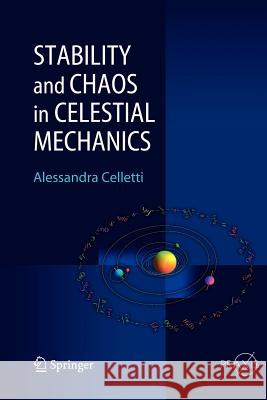Stability and Chaos in Celestial Mechanics » książka
Stability and Chaos in Celestial Mechanics
ISBN-13: 9783642261565 / Angielski / Miękka / 2012 / 264 str.
Stability and Chaos in Celestial Mechanics
ISBN-13: 9783642261565 / Angielski / Miękka / 2012 / 264 str.
(netto: 497,21 VAT: 5%)
Najniższa cena z 30 dni: 501,19
ok. 22 dni roboczych.
Darmowa dostawa!
The last decades have marked the beginning of a new era in Celestial Mech- ics. The challenges came from several di?erent directions. The stability theory of nearly integrable systems (a class of problems which includes many models of - lestial Mechanics) pro?ted from the breakthrough represented by the Kolmogorov Arnold Moser theory, which also provides tools for determining explicitly the - rameter values allowing for stability. A con?nement of the actions for exponential times was guaranteed by Nekhoroshev s theorem, which gives much information about the geography of the resonances. Performing ever-faster computer simu- tionsallowedustohavedeeperinsightsintomanyquestionsofDynamicalSystems, most notably chaos theory. In this context several techniques have been developed to distinguish between ordered and chaotic behaviors. Modern tools for computing spacecraft trajectories made possible the realization of many space missions, es- cially the interplanetary tours, which gave a new shape to the solar system with a lot of new satellites and small bodies. Finally, the improvement of observational techniques allowed us to make two revolutions in the sky: the solar system does not end with Pluto, but it extends to the Kuiper belt, and the solar system is not unique, but the universe has plenty of extrasolar planetary systems. Cookingalltheseingredientstogetherwiththeclassicaltheoriesdevelopedfrom the 17th to the 19th centuries, one obtains themodern Celestial Mechanics."
Alessandra Celletti s proposed book presents classical celestial mechanics and its interplay with dynamical systems in a way that would be suitable for advance level undergraduate students as well as postgraduate students and researchers. First she uses paradigmatic models, such as the logistic map or the standard map, to introduce the reader to the concepts of order, chaos, invariant curves, cantori, etc. The main numerical methods to investigate a dynamical system are presented: Poincare' maps, Lyapunov exponents, frequency analysis, Fast Lyapunov Indicators, etc. Then she reviews the classical two-body problem and proceeds to explore the three-body model in order to investigate orbital resonances and Lagrange solutions. As far as rotational dynamics are concerned, she details the derivation of the rigid body motion, and continues by discussing related topics, from spin-orbit resonances to dumbbell satellite dynamics.§Perturbation theory is then explored in full detail, both in classical, resonant and degenerate cases; practical examples of the application of perturbation theory are presented in connection to the precession of the perihelion or to the precession of the equinoxes. The main ideas of KAM theory are provided, and also a dissipative version of the theorem is discussed; furthermore long-term stability and converse KAM results are presented. She then explains the implementation of computer-assisted techniques, which allow the user to obtain rigorous results in good agreement with the astronomical expectations.§A perturbative approach to find periodic orbits is presented together with an application to the computation of the libration in longitude of the Moon. The study of collisions in the solar system is approached through regularization theory.











